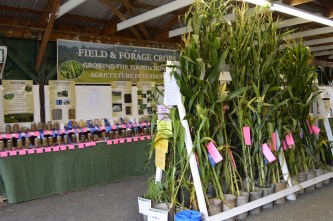Self-Certification of Small Farm Operators (CSFO) triggered by the Required Agricultural Practices (RAPs) is now ongoing. Info and forms for small farmers now required to certify at: agriculture.vermont.gov/sfo
One big change is the number of farms now falling under the requirement to have a nutrient management plan (NMP). “Vermont Agency of Agriculture, Food & Markets (VAAFM) understands that few Certified Small Farm Operations will have a complete Nutrient Management Plan (NMP) for 2017, but that farmers should be actively working towards NMP
completion by taking modified Morgan extractant soil samples and applying manure at agronomic rates.” If you have questions about CSFOs, taking samples, getting your NMP or other RAPs regulations, we can help you navigate this transition. Stop by our Extension office or give us a call!
August 7 , 8 a.m.-noon – Drop off crop entries to participate in our FIELD CROP EXHIBIT. Addison County Fair and Field Days August 8-12: We are looking forward to your entries. This is one way we connect with the public, describe the importance of agriculture, and how farming has changed over the years. From corn and hay to wheat and soybeans, help us show and tell everybody about the great crops you grow – then use your prize winnings on fair treats for the family!
, 8 a.m.-noon – Drop off crop entries to participate in our FIELD CROP EXHIBIT. Addison County Fair and Field Days August 8-12: We are looking forward to your entries. This is one way we connect with the public, describe the importance of agriculture, and how farming has changed over the years. From corn and hay to wheat and soybeans, help us show and tell everybody about the great crops you grow – then use your prize winnings on fair treats for the family!
See complete contest rules here. Or call our office and ask Karen for details [802-388-4969].
Champlain Valley Farmer Coalition’s monthly meetings and field day events are a great way for farmers to connect on water quality issues that go hand-in-hand with farm profitability. When faced with changing regulations and public views, we are stronger together. Come to a CVFC meeting or field day: discover and join this progressive, exciting group
of farmers and supporting business members. Schedule at:
www.champlainvalleyfarmercoalition.com















